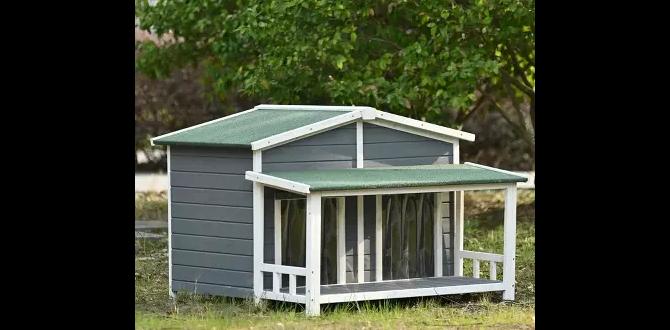Quick Summary: Caring for indoor hydrangeas is achievable with consistent watering, bright indirect light, and proper feeding. Protect them from drafts and extreme temperatures to encourage vibrant blooms and healthy growth, even in a home setting.
Do you dream of having those gorgeous, fluffy hydrangea blooms gracing your indoor space? It’s true, keeping these beauties happy inside can feel like a bit of a puzzle at first. Many plant lovers find their indoor hydrangeas droop or fail to flower, leading to frustration. But don’t worry! With a few simple, consistent steps, you can transform your indoor gardening game and enjoy breathtaking hydrangea blooms year-round. This guide will walk you through everything you need to know to become a pro at indoor hydrangea care. Let’s get those blooms popping!
—
Why Indoor Hydrangeas Can Be Tricky (And How to Solve It!)
Hydrangeas are often thought of as garden plants, native to outdoor environments where they enjoy ample space, natural rainfall, and seasonal changes. Bringing them indoors means mimicking those conditions as best as possible, which can be a challenge. They have specific needs for light, water, and humidity that differ from many common houseplants. When these needs aren’t met, they can quickly show signs of distress like wilting, yellowing leaves, or no flowers at all. The good news is that by understanding their unique requirements and providing the right environment, you can absolutely succeed in growing a thriving indoor hydrangea.
This guide is designed for beginners, breaking down each care step into easy-to-understand actions. We’ll cover watering techniques, light preferences, feeding schedules, and troubleshooting common issues. Our goal is to empower you with the knowledge to nurture your indoor hydrangea from a plant that’s just surviving to one that’s truly flourishing.
Understanding Your Indoor Hydrangea: What You Need to Know
Before we dive into the “how-to,” let’s get a basic understanding of what your indoor hydrangea needs to feel at home. Unlike many decorative houseplants, hydrangeas are deciduous shrubs that typically experience a dormant period outdoors. When grown indoors, especially in their blooming stage, they are essentially being asked to perform a role they’re not always biologically programmed for without some help. They demand consistent moisture and a good amount of light, and they are quite sensitive to sudden changes in their environment. Recognizing these core needs is the first step to successful care.
The most common type of hydrangea found for indoor sale is the Hydrangea macrophylla, often sold specifically for blooming indoors during winter or spring. These varieties are cultivated to produce flowers in a controlled environment. They usually come in a pot with an established bloom. Your job is to keep it that way!
Essential Care Steps for a Happy Indoor Hydrangea
Keeping your indoor hydrangea thriving is all about consistency. Think of it like tending to a very thirsty, sun-loving friend. Here’s a breakdown of the essential care steps that will make all the difference:
1. The Art of Watering: Don’t Let it Dry Out!
Hydrangeas are famously thirsty plants, and this is perhaps the most critical aspect of their indoor care. When grown outdoors, they benefit from generous rainfall. Indoors, you are their lifeline! Wilting is a common sign that your hydrangea needs water. Don’t wait for this; be proactive.
- When to Water: Check the soil moisture daily. Stick your finger about an inch into the soil. If it feels dry, it’s time to water. You can also lift the pot; a light pot usually means it’s dry.
- How to Water: Water thoroughly until water drains from the bottom of the pot. This ensures the entire root ball gets moistened. Discard any excess water that collects in the saucer after about 30 minutes to prevent root rot.
- Water Quality: Hydrangeas can be sensitive to chemicals in tap water, particularly fluoride and chlorine. If your tap water is heavily treated, consider using filtered water, rainwater, or letting tap water sit out overnight to allow some of the chlorine to dissipate.
- Consistency is Key: Aim for consistently moist, but not soggy, soil. This is the sweet spot for hydrangeas.
Pro Tip: Some experienced growers even recommend the “soak and drain” method. If your plant looks particularly droopy or you suspect it’s significantly dry, you can place the entire pot in a sink or basin of water for about 15-30 minutes, allowing it to soak up water from the bottom. Then, let it drain completely before returning it to its spot.
| Watering Indicator | Action Needed | Frequency (Approximate) |
|---|---|---|
| Soil dry to touch (1 inch deep) | Water thoroughly | Every 1-3 days (depends on environment) |
| Plant wilting | Water immediately; check soil first | As needed |
| Pot feels very light | Water thoroughly | When drying out |
2. The Right Light: Bright, But Not Too Intense
Hydrangeas love light, but they can be a bit particular about its intensity indoors. Too little light, and they won’t bloom. Too much direct, hot sun, and their leaves can scorch.
- Ideal Location: Place your hydrangea in a spot where it receives bright, indirect sunlight for at least 4-6 hours a day. An east-facing window is often perfect, as it provides gentle morning sun. A south or west-facing window can work too, but you might need to filter the light with sheer curtains to prevent overheating and leaf burn.
- Signs of Too Much Sun: Yellowing leaves, brown crispy edges, or wilting during the hottest part of the day can indicate too much direct sun.
- Signs of Too Little Sun: Leggy growth (long, weak stems), fewer or smaller leaves, and a complete lack of blooms suggest the plant isn’t getting enough light.
Helpful Resource: The Royal Horticultural Society (RHS) offers excellent advice on growing hydrangeas in pots, which can be applied to indoor environments, including light considerations.
3. Temperature and Humidity: Mimicking Nature
Hydrangeas prefer cooler temperatures than many common houseplants. Extreme heat or cold drafts can stress them out. They also appreciate a bit of humidity.
- Ideal Temperature: Aim for temperatures between 60-70°F (15-21°C) during the day and slightly cooler at night, around 50-60°F (10-15°C). Avoid placing your hydrangea near heat vents, air conditioners, or drafty windows and doors. Sudden temperature fluctuations are their enemy.
- Boosting Humidity: Indoor environments, especially during winter when heating systems are on, can be quite dry. To increase humidity around your hydrangea:
- Place the pot on a pebble tray filled with water. Ensure the bottom of the pot isn’t sitting directly in the water.
- Mist the leaves lightly with water occasionally, especially if the air is very dry. However, avoid misting if the plant is in direct sunlight, as water droplets can act like tiny magnifying glasses and scorch the leaves. Avoid misting foliage in cool, damp conditions as this can encourage fungal diseases.
- Group your hydrangea with other plants. Plants release moisture through transpiration, creating a slightly more humid microclimate when grouped together.
4. Feeding Your Hydrangea: Fueling the Blooms
To produce those magnificent blooms, your indoor hydrangea needs nutrients. However, over-fertilizing can be just as harmful as under-fertilizing. It’s best to use a balanced, water-soluble fertilizer during the active growing season.
- When to Fertilize: Start feeding your hydrangea once established (usually a few weeks after purchase, once it’s settled in). Fertilize during its active growing period, which is typically spring through late summer or early fall. Reduce or stop feeding in late fall and winter when growth naturally slows down.
- What Fertilizer to Use: A balanced, all-purpose liquid fertilizer (like a 10-10-10 or 20-20-20) is a good starting point. Some gardeners prefer fertilizers specifically formulated for flowering plants.
- How to Fertilize: Dilute the fertilizer to half the strength recommended on the package. Over-strength fertilizer can burn the roots. Apply the diluted fertilizer every 2-4 weeks, but only to moist soil. Never fertilize a dry plant, as this can cause root damage.
- Flower Color: While not achievable with all indoor cultivars and varieties (some are bred for specific colors or are genetically less responsive), for some Hydrangea macrophylla varieties, soil pH can influence bloom color. Acidic soil (lower pH) tends to produce blue blooms, while alkaline soil (higher pH) results in pink blooms. Aluminum is available to the plant in acidic soil, leading to blue flowers. The color you buy it in is often the color it will stay indoors unless you actively amend the soil pH consistently, which can be tricky for beginners.
5. Potting and Repotting: Giving Them Space to Grow
Your hydrangea comes in a pot, and it will likely stay in that pot for a while. Repotting is important for long-term health, but it’s not something you need to do frequently for indoor blooming specimens.
- Initial Pot: The pot your hydrangea comes in is usually designed for its needs when purchased in bloom. Ensure it has drainage holes!
- When to Repot: Repotting is generally only needed if the plant becomes severely root-bound (roots circling the pot tightly) or if the soil is degraded. For indoor potted hydrangeas, this might be every 1-2 years, ideally in the spring after the blooming period has passed.
- Choosing a New Pot: Select a pot that is only 1-2 inches larger in diameter than the current one. Too large a pot can lead to overwatering issues. Ensure the new pot also has drainage holes.
- Potting Mix: Use a good quality, well-draining potting mix. A mix designed for flowering plants or a general-purpose potting soil amended with perlite or sand for better drainage works well.
- Repotting Process: Gently remove the hydrangea from its old pot. Loosen any tightly bound roots at the bottom. Place it in the new pot at the same depth it was previously growing. Fill in with fresh potting mix and water thoroughly.
6. Pruning and Deadheading: Maintaining Shape and Encouraging New Growth
Pruning isn’t as intensive for indoor hydrangeas compared to their outdoor counterparts, but a little attention can keep them looking tidy and encourage future blooms.
- Deadheading: Once the blooms have faded and started to dry out, you can carefully cut them off. This prevents the plant from putting energy into seed production and can sometimes encourage it to produce more blooms, though this is less common with the types sold for indoor display. Use clean, sharp scissors or pruning shears. Cut the stem back to a leaf node or a side shoot.
- Shaping: If the plant becomes leggy or unruly, you can prune it back to maintain a desirable shape. Again, focus on cutting back to a leaf node. Avoid heavy pruning on flowering cultivars, as many bloom on old wood (stems from the previous year), and you might cut off future flowers. For indoor specimens, it’s usually best to do light shaping rather than significant pruning.
- Timing: The best time for any pruning is after the plant has finished blooming.
Common Indoor Hydrangea Problems and How to Fix Them
Even with the best care, you might encounter a few issues. Here are some common problems and how to solve them:
| Problem | Possible Cause | Solution |
|---|---|---|
| Wilting Leaves | Underwatering | Check soil moisture and water thoroughly. |
| Overwatering (leading to root rot) | Ensure good drainage, let soil dry slightly between waterings, and discard excess water from the saucer. | |
| Yellowing Leaves | Overwatering | See solution for wilting due to overwatering. |
| Nutrient deficiency (especially if anemic-looking) | Fertilize with a balanced liquid fertilizer as per instructions. | |
| Brown, Crispy Leaf Edges | Low humidity or too much direct sun/heat. | Increase humidity, move away from direct sun/heat source, and avoid drafts. |
| No Blooms | Insufficient light | Move to a brighter location with indirect light for 4-6 hours daily. |
| Incorrect pruning (cutting off old wood) or plant is stressed. | Prune lightly after bloom. Ensure consistent care. |
Encouraging Dormancy for Future Blooms (Optional but Recommended)
Many hydrangeas sold as indoor plants are forced to bloom out of season. To encourage them to rebloom in subsequent years, it’s beneficial to mimic their natural dormancy period.
- Post-Bloom Care: After the blooms fade and you’ve appropriately deadheaded or pruned, reduce watering and stop fertilizing.
- Cool Rest Period: Move the plant to a cooler location (around 40-50°F or 4-10°C) for about 10-12 weeks. A cool basement, an unheated garage, or a cool windowsill can work. Keep the soil barely moist during this time – just enough to prevent the roots from drying out completely.
- Awakening: In late winter or early spring, gradually reintroduce the plant to warmer temperatures and brighter light. Resume regular watering and fertilizing schedule. You should start to see new growth.
This dormancy period helps the plant rest and prepare for new blooms. It’s a bit more advanced, but it’s how you can keep your hydrangea happy for years to come.
Frequently Asked Questions About Indoor Hydrangea Care
Q1: How often should I water my indoor hydrangea?
A1: Check the soil daily. Water thoroughly whenever the top inch of soil feels dry. This could be every 1-3 days, depending on your home’s humidity and temperature. Consistency is key; don’t let it dry out completely.
Q2: Can I put my indoor hydrangea in direct sunlight?
A2: No, avoid direct, harsh sunlight, especially afternoon sun, as it can scorch the leaves. Bright, indirect light is best. An east-facing window or a spot with filtered light from a south or west window is ideal.
Q3: My hydrangea is wilting. What should I do?
A3: First, check the soil. If it’s dry, water it thoroughly and give it some time to rehydrate. If the soil is moist, the wilting might be due to overwatering or stress from temperature fluctuations. Ensure it’s not in a draft or near a heat source, and that its pot has drainage.
Q4: How do I get my hydrangea to bloom indoors?
A4: Ensure it receives adequate bright, indirect light (4-6 hours daily), consistent watering, and is kept at a suitable temperature without drafts. Fertilization during the growing season also helps fuel blooms. Some varieties naturally bloom indoors, while others purchased for indoor bloom may need a cool dormancy period later to rebloom.
Q5: Can I repot my store-bought hydrangea right away?
A5: It’s usually best to let your newly purchased hydrangea settle in for a week or two before repotting, allowing it to adjust to its new home. Repot when necessary, ideally in spring, into a pot only slightly larger than the original, using well-draining potting mix.
Q6: What are these white specs on my hydrangea leaves?
A6: White specks can sometimes be mineral deposits from tap water used for watering or misting. If it’s powdery, it could be a sign of powdery mildew, often caused by poor air circulation and high humidity. Ensure good airflow and avoid watering leaves.
Q7: How do I make my hydrangea blue?
A7: Flower color in Hydrangea macrophylla is mainly influenced by soil pH. For blue blooms, the soil needs to be acidic (pH below 6.0), making aluminum available to the plant. This is usually achieved outdoors with amendments. For indoor plants, maintaining a specific acidic pH consistently can be very challenging and may not yield results, as many are bred for specific colors. Enjoy the color your plant came with, or look into specialized outdoor planting if color change is a priority.</





